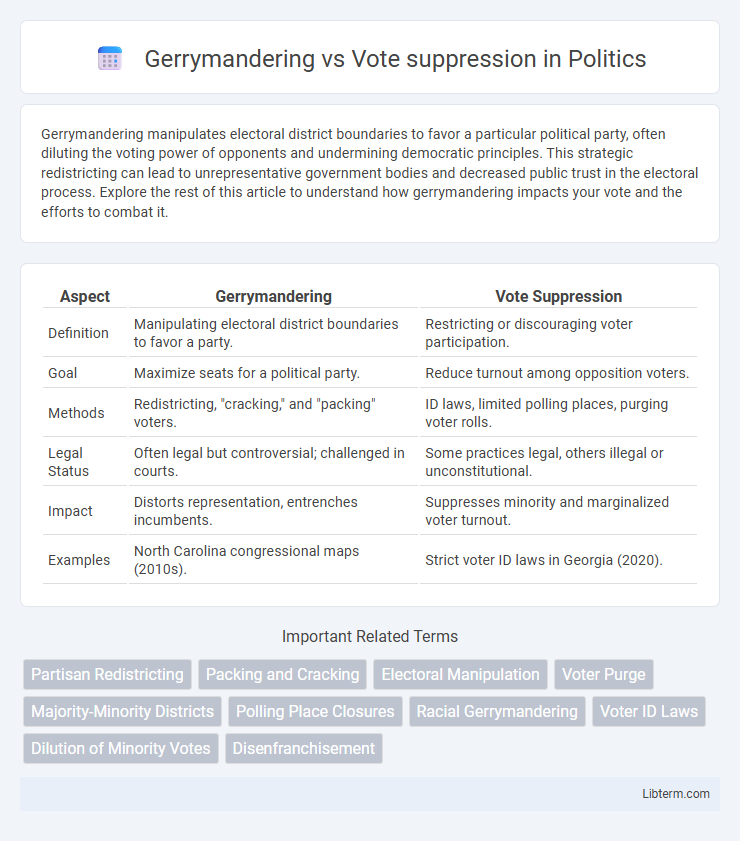Gerrymandering manipulates electoral district boundaries to favor a particular political party, often diluting the voting power of opponents and undermining democratic principles. This strategic redistricting can lead to unrepresentative government bodies and decreased public trust in the electoral process. Explore the rest of this article to understand how gerrymandering impacts your vote and the efforts to combat it.
Table of Comparison
| Aspect | Gerrymandering | Vote Suppression |
|---|---|---|
| Definition | Manipulating electoral district boundaries to favor a party. | Restricting or discouraging voter participation. |
| Goal | Maximize seats for a political party. | Reduce turnout among opposition voters. |
| Methods | Redistricting, "cracking," and "packing" voters. | ID laws, limited polling places, purging voter rolls. |
| Legal Status | Often legal but controversial; challenged in courts. | Some practices legal, others illegal or unconstitutional. |
| Impact | Distorts representation, entrenches incumbents. | Suppresses minority and marginalized voter turnout. |
| Examples | North Carolina congressional maps (2010s). | Strict voter ID laws in Georgia (2020). |
Introduction to Gerrymandering and Vote Suppression
Gerrymandering manipulates electoral district boundaries to favor a particular political party, undermining fair representation and distorting election outcomes. Vote suppression involves tactics such as strict voter ID laws, limited polling places, and purging voter rolls to reduce electoral participation, especially among marginalized groups. Both practices weaken democratic processes by restricting voter influence and skewing election results.
Defining Gerrymandering: Manipulating Electoral Boundaries
Gerrymandering involves manipulating electoral boundaries to create an unfair advantage for a particular political party or group, often resulting in distorted representation. This practice can dilute the voting power of certain communities by concentrating or dispersing voters across districts to influence election outcomes. Unlike vote suppression, which limits voter turnout through barriers, gerrymandering strategically redraws district lines to control electoral influence without directly restricting voter participation.
Vote Suppression: Limiting Access to the Ballot
Vote suppression involves tactics designed to limit or obstruct eligible voters from casting their ballots, such as strict voter ID laws, reduced polling places, and purging voter rolls. These measures disproportionately affect minority, elderly, and low-income communities, effectively diminishing their political influence. Unlike gerrymandering, which manipulates district boundaries, vote suppression directly restricts voter participation at the individual level.
Historical Origins and Evolution of Both Practices
Gerrymandering originated in the early 19th century, named after Governor Elbridge Gerry's 1812 redistricting plan in Massachusetts designed to favor his party, while vote suppression traces back to post-Reconstruction Southern United States tactics like poll taxes and literacy tests aimed at disenfranchising African American voters. Both practices evolved through legal challenges and technological changes, with gerrymandering now often employing sophisticated data analytics and geographic information systems to manipulate district boundaries. Vote suppression has increasingly incorporated restrictive voter ID laws and purging of voter rolls, representing a continuous effort to limit electoral participation by marginalized groups.
Methods and Strategies Used in Gerrymandering
Gerrymandering employs methods such as "cracking" and "packing" to manipulate electoral district boundaries, diluting the voting power of opposing groups and ensuring a political advantage. Strategies include the strategic redrawing of district lines to concentrate or disperse voters based on party affiliation, race, or ethnicity, often utilizing advanced geographic information systems (GIS) and data analytics for precision. These tactics contrast with vote suppression, which focuses on limiting voter access through restrictive laws and practices rather than altering district maps.
Common Tactics of Vote Suppression
Common tactics of vote suppression include stringent voter ID laws, purging voter rolls, limiting early voting, and closing polling places in minority neighborhoods. These practices disproportionately affect marginalized communities and reduce overall voter turnout by creating unnecessary obstacles. Gerrymandering, while focused on manipulating district boundaries to influence election outcomes, often works in tandem with vote suppression to weaken political power.
Legal and Political Implications
Gerrymandering manipulates electoral district boundaries to favor specific political parties, undermining fair representation and often leading to legal challenges based on constitutional claims of equal protection violations. Vote suppression employs tactics like stringent voter ID laws and purging voter rolls to disproportionately disenfranchise certain demographics, raising significant legal disputes over voting rights and access. Both practices erode democratic principles, prompting bipartisan legislative efforts and court rulings aimed at safeguarding electoral integrity and voter equality.
Impacts on Minority Voters and Marginalized Groups
Gerrymandering manipulates electoral district boundaries to dilute the voting power of minority groups, resulting in diminished political representation and influence. Vote suppression tactics such as strict ID laws, reduced polling places, and voter roll purges disproportionately affect marginalized communities by creating barriers to ballot access. Both practices undermine democratic equity by eroding the electoral participation and policy impact of historically disadvantaged populations.
Reform Efforts and Solutions to Combat Both Issues
Reform efforts to combat gerrymandering and vote suppression include independent redistricting commissions that create fair and transparent electoral maps based on nonpartisan criteria to prevent manipulation of district boundaries. Legislative measures such as the For the People Act and the John Lewis Voting Rights Advancement Act aim to strengthen voting rights protections, enhance accessibility, and enforce stricter penalties against discriminatory practices. Technological solutions, increased public awareness, and court interventions also play critical roles in ensuring equitable representation and protecting voter access nationwide.
Conclusion: Safeguarding Fair and Free Elections
Safeguarding fair and free elections requires eliminating both gerrymandering and vote suppression, as these practices systematically undermine democratic representation. Implementing independent redistricting commissions and enforcing strict voting rights protections can restore electoral integrity and promote equitable voter participation. Transparent election processes and robust legal frameworks are critical to ensuring every citizen's vote carries equal weight.
Gerrymandering Infographic

 libterm.com
libterm.com